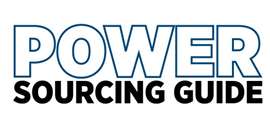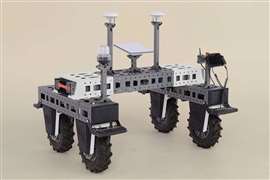Updated: How much do the world’s biggest OEMs spend on R&D?
02 June 2025
The race to reinvent construction equipment is gathering pace.
Faced with the twin pressures of decarbonisation and digital transformation - not to mention unpredictable economic headwinds - manufacturers are doubling down on innovation.
Their latest financial results reveal just how much they’re investing to stay ahead of the curve. For the world’s top construction equipment makers, research and development is not just a cost, it’s a battleground and several OEMs have either increased that they spend as a share of their total revenue, or have announced plans to do so.
Construction Briefing crunches the numbers from the top 10 global OEMs to see how much of their revenue is going into R&D and where those funds are being directed.
The headline figure for each company (ranked in the order in which they appear in the latest version of the Yellow Table) shows its research and development cost to sales ratio, rather than a monetary value. That’s because some companies operate in multiple industry segments in addition to their construction activities and tend show only what their research and development costs were as they relate to the entire group. That can make the monetary value of what some companies invest look significantly higher than rivals whose activities focus purely on construction machinery:
1) Caterpillar: 3.2%
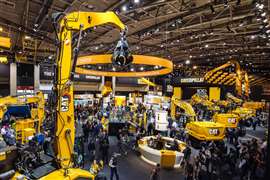 Caterpillar’s vast indoor stand proved to be one of the major attractions for visitors to Bauma 2025 (Image: Ervin Bedeli)
Caterpillar’s vast indoor stand proved to be one of the major attractions for visitors to Bauma 2025 (Image: Ervin Bedeli)
Caterpillar spent a total of US$2.1 billion on research and development in its 2024 financial year. The sum represented a 3.2% share of its total revenue, which was very close to the 3.1% it spent in 2023.
The amount was below the $2.5 billion chief financial officer Andrew Bonfield predicted last year.
In its 2024 full-year financial results presentation earlier this year, Caterpillar executives said the company continues to invest in the core technologies of autonomy, alternative fuels, connectivity and digital and electrification.
They also pointed to how the company exhibited a Cat 972 wheel loader retrofitted to be an extended electrified machine hybrid technical demonstrator at the CES show in the US. The machine can run fully battery electric for several hours with an onboard generator and charge that allows a full day of uptime without investment in charging infrastructure.
Much of its research and development activities take place at its Technical Centres in Aurora and Mossville, Illinois.
2) Komatsu: 2.7%
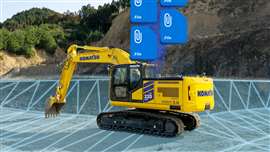 Smart Construction Remote is a cloud-based solution that enables users to access and control both Komatsu and non-Komatsu machine guidance and control systems remotely. (Photo: Komatsu)
Smart Construction Remote is a cloud-based solution that enables users to access and control both Komatsu and non-Komatsu machine guidance and control systems remotely. (Photo: Komatsu)
Komatsu is planning to gradually increase the amount of money it spends on research and development. According to its 2024 financial results, it spent 110.5 billion Japanese yen (around US$772 million) on R&D. That was a 2.7% share of its total revenue of 4.1 trillion Japanese yen (US$28.7 billion).
That was up very slightly on last year’s 2.6% share and Komatsu said it had plans for it to increase further to 3.2% of sales in 2025. It said it will continue to focus on its priority areas of electrification and digitalisation.
At Bauma in Germany this year, Komatsu unveiled the fruits of some of its research efforts, showcasing 13 new models including a new-generation hydraulic excavator, the PC220LCi-12, equipped with the latest 3D construction features, and the new-generation wheel loader WA485-11. It also highlighted its Smart Construction digital product, which promises to enhance jobsite operations through visualisation and optimisation.
3) Deere & Co: 4.4%
 Wirtgen’s Benjamin Grüber demonstrates Mix Assist, the automation function available on the company’s new WR series recyclers/stabilizers (Image: Ervin Bedeli)
Wirtgen’s Benjamin Grüber demonstrates Mix Assist, the automation function available on the company’s new WR series recyclers/stabilizers (Image: Ervin Bedeli)
John Deere spent $2.3 billion on R&D in its 2024 financial year, on revenue of nearly $51.7 billion, which worked out as an increased share of 4.4%, up from 3.9% in 2023.
It is worth noting that sales in John Deere’s construction and forestry division, which also includes brands such as Wirtgen, Vögele, Hamm and Kleemann, accounts for around a quarter of the group’s overall sales. The remainder is accounted for by its agricultural machinery and financial services operations.
However, John Deere has published a group-wide figure for its research and development costs, which is not broken down by division.
The company continues to focus its research and development spend on intelligent solutions for its customers through digital capabilities, automation, autonomy, and alternative power technologies.
4) XCMG: 5.5% to 6%
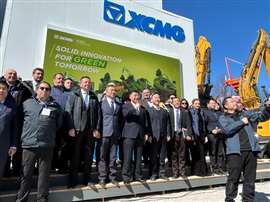 Yang Dongsheng, CEO and chairman of XCMG, gives a thumbs-up after a press event photo-op (Image: Mitchell Keller)
Yang Dongsheng, CEO and chairman of XCMG, gives a thumbs-up after a press event photo-op (Image: Mitchell Keller)
XCMG said that it spent 5.5%-6% of its total revenue on R&D in its latest financial year, when contacted by Construction Briefing.
The company is working on full electrification across all product series under its ‘Green Mountain’ new energy line, and in April this year it said that 19% of its product portfolio now comprises green innovations.
Among other recent innovations, it has launched its next-generation Xrea Global Telematics Platform, to enable cross-border fleet management by integrating the internet of things (IoT), big data, and cloud computing.
Earlier this year, XCMG Hanyun, an industrial internet company incubated by XCMG, has integrated with Chinese artificial intelligence platform DeepSeek. The integration will concentrate on critical areas within the internet of vehicles sector, including big data analysis, predictive maintenance, and fault pattern databases.
5) Liebherr: 4.6%
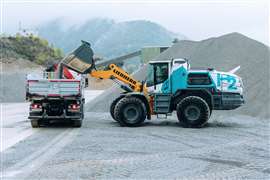 Liebherr’s hydrogen-fuel wheel loader prototype (Photo: Liebherr)
Liebherr’s hydrogen-fuel wheel loader prototype (Photo: Liebherr)
Liebherr’s R&D investment as a total of overall sales was 4.6% in its 2024 financial year, which was in line with 2023’s 4.5% share. In 2024, it spent a total of €666 million ($754.6 million), on sales of €14,622 million ($16.6 billion).
It is worth noting that although the majority of Liebherr’s activities relate to construction and mining (through its earthmoving, materials handling, mobile and crawler cranes, tower cranes, concrete technology, mining and maritime cranes segments), the business also operates in the refrigerators and freezers and aerospace and transportation systems sectors. That means that not all of the money the business invests in research and development necessarily ends up in construction applications.
Liebherr said a large part of its R&D spending in 2024 was devoted to developing new products, as well as research projects in collaboration with universities, colleges and research institutes. “The areas of alternative drives, autonomy and digitalisation remained focal points of research and development, which saw existing technologies refined and numerous new machines, components and solutions added to the product programme,” it said.
During the year, Liebherr presented what it claimed was the first prototype of a large wheel loader with a hydrogen engine, the L 566 H. Its engine is also made by Liebherr and is manufactured in Bulle (Switzerland). In the field of electric drives, Liebherr started series delivery of the LPO 100 mobile energy storage system and the development of the even more powerful LPO 600 prototype. Liebherr also worked on creating hybrid versions of its machines.
In other product segments, the Group worked on extending its portfolio in the field of autonomy and automation. Its LiReCon teleoperation unit is now ready for series production and the company said it had also won an award for an automated system for the disassembly of used batteries.
6) Sany: 5%
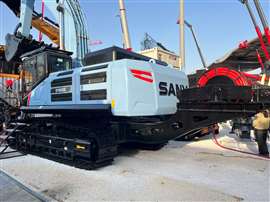 Sany 55t excataor with power charging cable reer attached to the counterweight. (Photo: Construction Briefing)
Sany 55t excataor with power charging cable reer attached to the counterweight. (Photo: Construction Briefing)
Sany spent 5% of its annual revenue on R&D, it confirmed to Construction Briefing.
The Chinese OEM has recently debuted a range of electric machines including its largest pure electric lattice boom crawler crane, featuring a high-capacity CATL battery that can last for nine hours of operation. It has also launched its first 5-ton e-roller, that can operator for over 7 hours and charge in 60 minute, as well as its flagship SY215E electric excavator, powered by a 422kWh CATL battery, ensuring six to eight hours of continuous operation.
Meanwhile, Sany Heavy Machinery’s Large Excavator R&D Institute has developd the Mechlink Intelligent Excavation System, in collaboration with Yoawu Technology. Designed for large excavators in harsh environments, it uses ultra-low latency 5G for L2-level automated intelligent excavation.
At this year’s Bauma, the company offered a live demonstration of a remote-controlled excavator located in Huzhou, China, which allowed an operator to control a machine from the show in Munich, Germany, 8,500km away.
7) Hitachi Construction Machinery: 2.7%
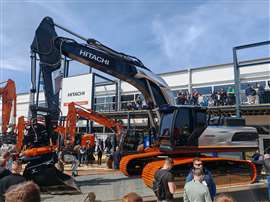 Hitachi’s Landcros One concept excavator at Bauma 2025 (Image: Neil Gerrard)
Hitachi’s Landcros One concept excavator at Bauma 2025 (Image: Neil Gerrard)
In its 2024 financial results, Hitachi Construction Machinery reported sales of nearly 1.4 trillion yen (US$9.6 billion). It also stated that its research and development spend is 2.7% of total sales, which would make the figure around 37 billion yen (US$258.6 million).
The figures represent an increased share on the 1.9% reported in 2023 and returns to around the level of the 2.5% and 3% it spent in 2022 and 2021 respectively.
Last year, Hitachi Construction Machinery established the new Landcros concept, which it said would take into account the transition from ownership to usage and increase environmental awareness. It was also billed as an acknowledgement that the market not only requires high-quality, high-performance machinery, but also optimised operation throughout a machine’s lifecycle.
At Bauma 2025, it unveiled the attention-grabbing Landcros One concept machine, developed in partnership with Granstudio. The machine has a modular cabin integrating AI-assisted interfaces and gamified controls. The machine also offers three adaptable powertrain options: electric, hydrogen, and diesel.
8) Volvo Group: 6.1%
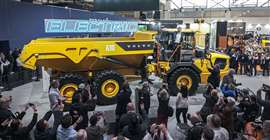 The Volvo A30 Electric was unveiled for the first time at Bauma 2025. Photo: Volvo CE
The Volvo A30 Electric was unveiled for the first time at Bauma 2025. Photo: Volvo CE
Volvo Group was another of the major OEMs to see its research and development spending, as a proportion of overall group sales, increase in 2024.
The company spent a total of nearly SEK 31 billion (US$3.2 billion) on R&D during the financial year, on a total revenue of almost SEK 505 billion (US$46.5 billion). That represented a 6.1% share of sales, up from 5% in 2023.
Like John Deere, however, that figure relates to spending across the entire group, which includes its trucks, buses and Volvo Penta operations.
Volvo said that a “substantial part” of investments are directed towards zero tailpipe emissions technology, including battery-electric, fuel cell-electric or internal combustion engines running on lower carbon fuels.
9) JCB: 3% (estimated)
 JCB drove a hydrogen-fuelled backhoe loader past the Palace of Westminster to celebrate a change in legislation that allows hydrogen-fuelled construction and agricultural machinery to use UK roads (Image: JCB)
JCB drove a hydrogen-fuelled backhoe loader past the Palace of Westminster to celebrate a change in legislation that allows hydrogen-fuelled construction and agricultural machinery to use UK roads (Image: JCB)
JCB, based in the UK, does not publish data relating to its spending on research and development and declined to comment when contacted by Construction Briefing.
Its latest annual financial results, for 2023, indicated that it generated sales of £6.5 billion (US$8.7 billion). Meanwhile, a Construction Equipment Association (CEA) report dating back to 2019 suggested that JCB’s R&D spend was 3% of revenue, with a focus on digitalisation and advanced telematics software.
That would put JCB’s total R&D spend at around £195 million (US$243.8 million).
The company is well known for developing a new hydrogen internal combustion engine. It recently drove a hydrogen-fuelled backhoe loader past the Palace of Westminster in London to mark a change in UK law that allows construction and agricultural machinery powered by hydrogen to use the public highways. At the same time, the company confirmed that it has invested £100 million (US$125 million) developing its hydrogen combustion technology.
That is in addition to its work on electrification. The company now offers an extensive range of fully electric machinery, including excavators, site dumpers, telehandlers, access platforms, wheel loaders and articulated booms.
10) Sandvik: 4.1%
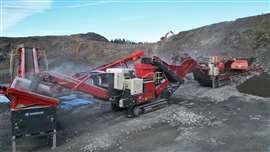 The new QH443E is Sandvik’s flagship Q-Range electric-driven cone plant. Image: Sandvik
The new QH443E is Sandvik’s flagship Q-Range electric-driven cone plant. Image: Sandvik
Swedish multinational engineering group Sandvik, which specialises in machinery for the mining and infrastructure industries, revealed in its 2024 annual report that it spent SEK 5 billion (US$528 million) on R&D during the year, across the entire group.
That was a slight increase on the 3.8% of revenue it spent the year before.
Sandvik said it had a portfolio of 8,264 active patents, as of the end of its 2024 financial year, with 1,157 new patents granted during the year.
The company said that its R&D priorities are machining materials and process development, powder metallurgy, electrification, and digital solutions.
POWER SOURCING GUIDE
The trusted reference and buyer’s guide for 83 years
The original “desktop search engine,” guiding nearly 10,000 users in more than 90 countries it is the primary reference for specifications and details on all the components that go into engine systems.
Visit Now
STAY CONNECTED




Receive the information you need when you need it through our world-leading magazines, newsletters and daily briefings.
CONNECT WITH THE TEAM










